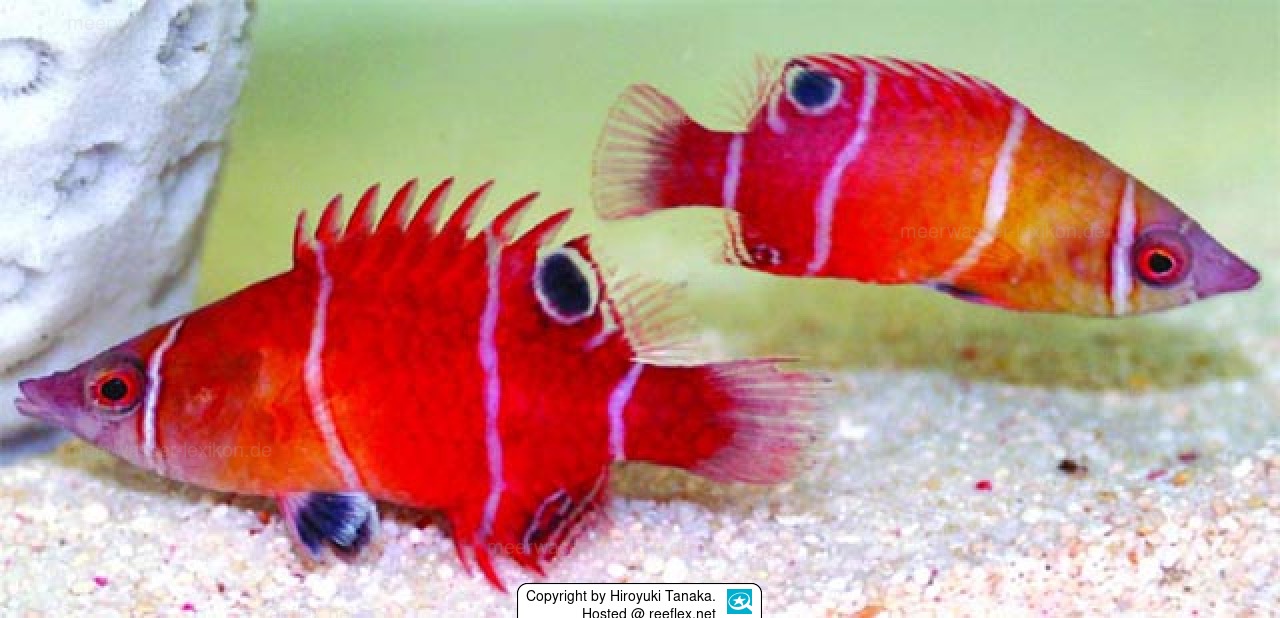Info
Wetmorella tanakai, Randall & Kuiter, 2007
Wetmorella tanakai, Randall & Kuiter, 2007
A very pretty fish, it took food immediately and makes a very bright impression to me at all.
Unfortunately the cave wrasses are anything but cheap to acquire.
According to literature the genus Wetmorella lives in darker caves.
Should just because of their delicacy not be kept with too large fish, otherwise you can hardly see them.
A really good keeper for the community aquarium, but large and fast fish should be missing!
Edit from 02.02.09 according to Peter Schmiedel:
What we know / knew as Wetmorella triocellata so far was described by Jack Randall as a new species Wetmorella tanakai.
Wetmorella tanakai is distinguished from the other two Wetmorella species, Wetmorella albofasciata and Wetmorella nigropinnata, by a narrow, oblique white bar behind the eye and two parallel, narrow, white bars in the middle of the body that are slightly oblique.
Wetmorella albofasciata has two narrow white bars on the body, but these converge ventrally. Wetmorella nigropinnata has two white bars on the body only as juvenile and subadult, but they are broad and slightly oblique in the other direction. Wetmorella tanakai also has a longer head, longer snout, and narrower interorbital space.
Etymology: the species name "tanakai" honors Dr. Hiroyuki Tanaka, the wrasse.
The photos of the living wrasses were taken by Dr. Hiroyuki Tanaka, many thanks.
Jumping guard
A jumping guard prevents (nocturnal) fish from jumping out.
Wrasses, blennies, hawkfishs and gobies jump out of an unprotected tank in fright if their night rest is disturbed, unfortunately these jumpers are found dried up in the morning on carpets, glass edges or later behind the tank.
https://www.korallenriff.de/en/article/1925_5_Jump_Protection_Solutions_for_Fish_in_the_Aquarium__5_Net_Covers.html
A small night light also helps, as it provides the fish with a means of orientation in the dark!
Wetmorella tanakai, Randall & Kuiter, 2007
A very pretty fish, it took food immediately and makes a very bright impression to me at all.
Unfortunately the cave wrasses are anything but cheap to acquire.
According to literature the genus Wetmorella lives in darker caves.
Should just because of their delicacy not be kept with too large fish, otherwise you can hardly see them.
A really good keeper for the community aquarium, but large and fast fish should be missing!
Edit from 02.02.09 according to Peter Schmiedel:
What we know / knew as Wetmorella triocellata so far was described by Jack Randall as a new species Wetmorella tanakai.
Wetmorella tanakai is distinguished from the other two Wetmorella species, Wetmorella albofasciata and Wetmorella nigropinnata, by a narrow, oblique white bar behind the eye and two parallel, narrow, white bars in the middle of the body that are slightly oblique.
Wetmorella albofasciata has two narrow white bars on the body, but these converge ventrally. Wetmorella nigropinnata has two white bars on the body only as juvenile and subadult, but they are broad and slightly oblique in the other direction. Wetmorella tanakai also has a longer head, longer snout, and narrower interorbital space.
Etymology: the species name "tanakai" honors Dr. Hiroyuki Tanaka, the wrasse.
The photos of the living wrasses were taken by Dr. Hiroyuki Tanaka, many thanks.
Jumping guard
A jumping guard prevents (nocturnal) fish from jumping out.
Wrasses, blennies, hawkfishs and gobies jump out of an unprotected tank in fright if their night rest is disturbed, unfortunately these jumpers are found dried up in the morning on carpets, glass edges or later behind the tank.
https://www.korallenriff.de/en/article/1925_5_Jump_Protection_Solutions_for_Fish_in_the_Aquarium__5_Net_Covers.html
A small night light also helps, as it provides the fish with a means of orientation in the dark!







 Dr. Hiroyuki Tanaka, Japan
Dr. Hiroyuki Tanaka, Japan





